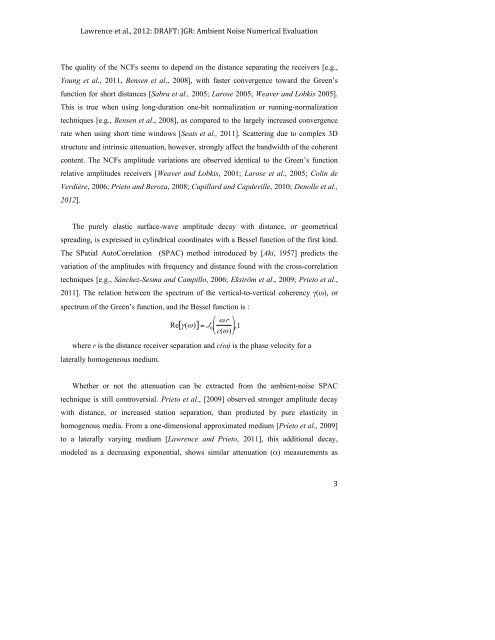Lawrence et al., 2012: DRAFT: JGR: Ambient Noise Numerical ...
Lawrence et al., 2012: DRAFT: JGR: Ambient Noise Numerical ...
Lawrence et al., 2012: DRAFT: JGR: Ambient Noise Numerical ...
You also want an ePaper? Increase the reach of your titles
YUMPU automatically turns print PDFs into web optimized ePapers that Google loves.
<strong>Lawrence</strong> <strong>et</strong> <strong>al</strong>., <strong>2012</strong>: <strong>DRAFT</strong>: <strong>JGR</strong>: <strong>Ambient</strong> <strong>Noise</strong> Numeric<strong>al</strong> Ev<strong>al</strong>uation<br />
The qu<strong>al</strong>ity of the NCFs seems to depend on the distance separating the receivers [e.g.,<br />
Young <strong>et</strong> <strong>al</strong>., 2011, Bensen <strong>et</strong> <strong>al</strong>., 2008], with faster convergence toward the Green’s<br />
function for short distances [Sabra <strong>et</strong> <strong>al</strong>., 2005; Larose 2005; Weaver and Lobkis 2005].<br />
This is true when using long-duration one-bit norm<strong>al</strong>ization or running-norm<strong>al</strong>ization<br />
techniques [e.g., Bensen <strong>et</strong> <strong>al</strong>., 2008], as compared to the largely increased convergence<br />
rate when using short time windows [Seats <strong>et</strong> <strong>al</strong>., 2011]. Scattering due to complex 3D<br />
structure and intrinsic attenuation, however, strongly affect the bandwidth of the coherent<br />
content. The NCFs amplitude variations are observed identic<strong>al</strong> to the Green’s function<br />
relative amplitudes receivers [Weaver and Lobkis, 2001; Larose <strong>et</strong> <strong>al</strong>., 2005; Colin de<br />
Verdière, 2006; Pri<strong>et</strong>o and Beroza, 2008; Cupillard and Capdeville, 2010; Denolle <strong>et</strong> <strong>al</strong>.,<br />
<strong>2012</strong>].<br />
The purely elastic surface-wave amplitude decay with distance, or geom<strong>et</strong>ric<strong>al</strong><br />
spreading, is expressed in cylindric<strong>al</strong> coordinates with a Bessel function of the first kind.<br />
The SPati<strong>al</strong> AutoCorrelation (SPAC) m<strong>et</strong>hod introduced by [Aki, 1957] predicts the<br />
variation of the amplitudes with frequency and distance found with the cross-correlation<br />
techniques [e.g., Sánchez-Sesma and Campillo, 2006; Ekström <strong>et</strong> <strong>al</strong>., 2009; Pri<strong>et</strong>o <strong>et</strong> <strong>al</strong>.,<br />
2011]. The relation b<strong>et</strong>ween the spectrum of the vertic<strong>al</strong>-to-vertic<strong>al</strong> coherency γ(ω), or<br />
spectrum of the Green’s function, and the Bessel function is :<br />
where r is the distance receiver separation and c(ω) is the phase velocity for a<br />
later<strong>al</strong>ly homogeneous medium.<br />
Wh<strong>et</strong>her or not the attenuation can be extracted from the ambient-noise SPAC<br />
technique is still controversi<strong>al</strong>. Pri<strong>et</strong>o <strong>et</strong> <strong>al</strong>., [2009] observed stronger amplitude decay<br />
with distance, or increased station separation, than predicted by pure elasticity in<br />
homogenous media. From a one-dimension<strong>al</strong> approximated medium [Pri<strong>et</strong>o <strong>et</strong> <strong>al</strong>., 2009]<br />
to a later<strong>al</strong>ly varying medium [<strong>Lawrence</strong> and Pri<strong>et</strong>o, 2011], this addition<strong>al</strong> decay,<br />
modeled as a decreasing exponenti<strong>al</strong>, shows similar attenuation (α) measurements as<br />
,1<br />
3
















